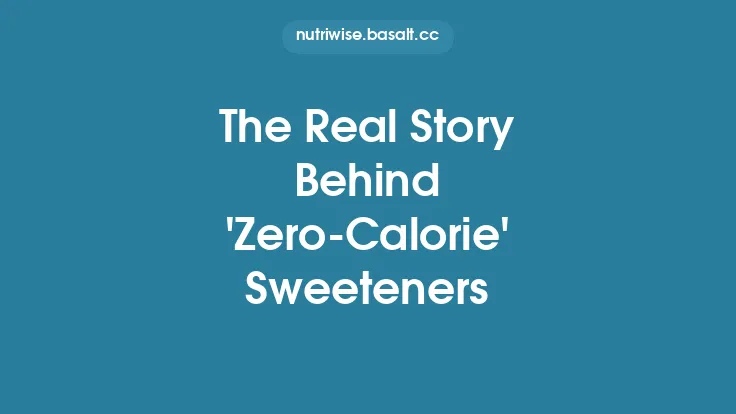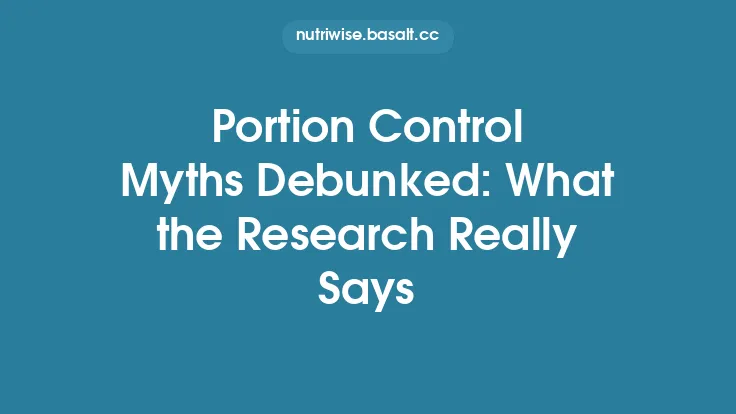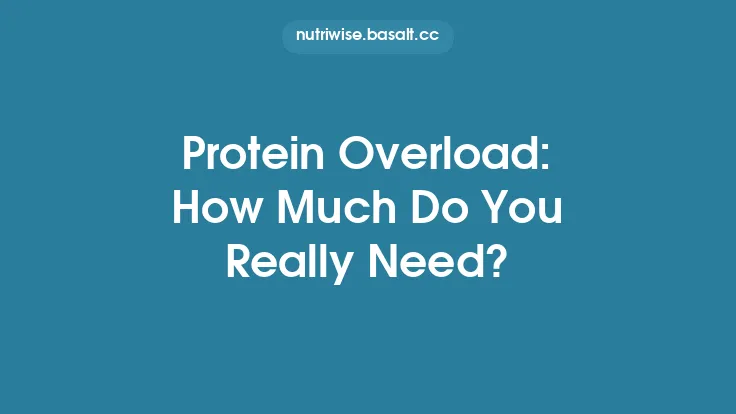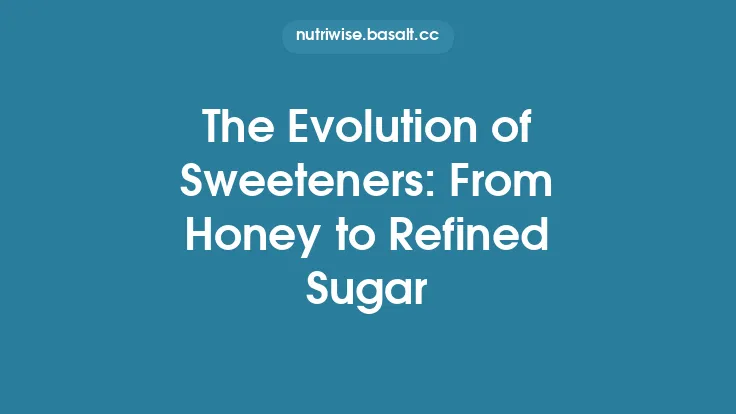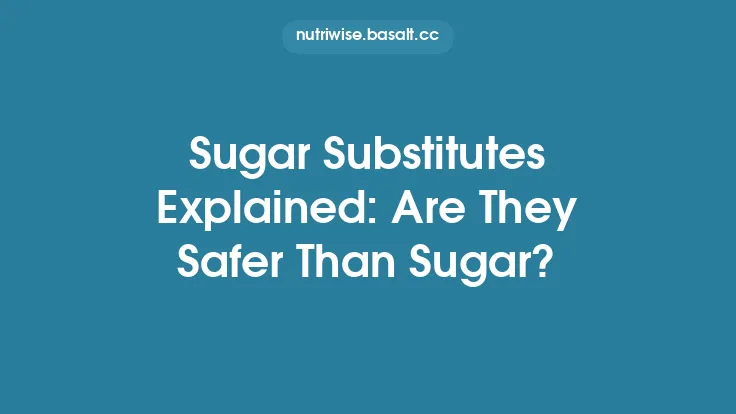Zero‑calorie sweeteners (ZCSs) have become a staple on grocery shelves, in diet sodas, and on the tables of anyone trying to curb sugar intake. Their promise is simple: enjoy the sweet taste you love without adding any calories, and therefore, without sabotaging weight‑loss efforts. Yet, the reality is more nuanced. Below we unpack the chemistry, physiology, and research behind these sweeteners to answer the question that many consumers ask: Are zero‑calorie sweeteners truly weight‑friendly?
What Are Zero‑Calorie Sweeteners?
Zero‑calorie sweeteners, also called non‑nutritive sweeteners (NNS) or artificial sweeteners, are compounds that provide a sweet taste at concentrations far lower than sucrose (table sugar). Because they are effective at milligram‑to‑microgram levels, the amount consumed in a typical serving contributes negligible energy—often listed as “0 kcal” on nutrition labels.
Common ZCSs include:
| Sweetener | Origin | Sweetness Relative to Sucrose | Typical Uses |
|---|---|---|---|
| Aspartame | Synthetic (di‑peptide of phenylalanine & aspartic acid) | ~180–200× | Diet sodas, tabletop sweeteners, sugar‑free desserts |
| Sucralose | Synthetic (chlorinated sucrose) | ~600× | Baking, beverages, processed foods |
| Saccharin | Synthetic (sulfonamide) | ~300–400× | Tabletop sweeteners, canned fruits |
| Acesulfame‑K | Synthetic (potassium salt) | ~200× | Soft drinks, chewing gum |
| Neotame | Synthetic (derivative of aspartame) | ~7,000–13,000× | Commercial food production |
| Stevia (steviol glycosides) | Plant‑derived (Stevia rebaudiana) | ~200–300× | Natural‑sweetener blends, beverages |
| Monk fruit extract (mogrosides) | Plant‑derived (Siraitia grosvenorii) | ~150–250× | Low‑calorie sauces, beverages |
Although the term “artificial” is often applied, several ZCSs are derived from natural sources (e.g., stevia, monk fruit). The unifying feature is that they activate the sweet‑taste receptors on the tongue (T1R2/T1R3) without providing metabolizable carbohydrates.
How They Are Metabolized: The Science Behind Zero Calories
The “zero‑calorie” label is not a misnomer; it reflects the fact that most ZCSs are either not absorbed, are excreted unchanged, or are metabolized in pathways that do not yield net energy.
| Sweetener | Absorption & Metabolism | Excretion |
|---|---|---|
| Aspartame | Hydrolyzed in the gut into phenylalanine, aspartic acid, and methanol; each component is metabolized like any other amino acid or alcohol. The total caloric contribution (~4 kcal g⁻¹) is negligible because the amount used is <0.02 g per serving. | Urine (as metabolites) |
| Sucralose | Poorly absorbed (~15 %); the majority passes through the gastrointestinal tract unchanged. The absorbed fraction is largely excreted unchanged in urine. | Feces (≈85 %), urine (≈15 %) |
| Saccharin | Not metabolized; absorbed and rapidly excreted unchanged. | Urine |
| Acesulfame‑K | Rapidly absorbed, not metabolized, excreted unchanged. | Urine |
| Neotame | Similar to aspartame; hydrolyzed to its constituent amino acids and a small amount of methanol. | Urine |
| Stevia (steviol glycosides) | Hydrolyzed by gut bacteria to steviol, which is absorbed and conjugated in the liver to steviol glucuronide, then excreted. | Urine |
| Monk fruit (mogrosides) | Metabolized by intestinal flora to aglycones, then absorbed and excreted. | Urine |
Because the metabolic fate of these compounds does not generate usable ATP for the body, they contribute effectively zero calories in the context of energy balance.
Impact on Energy Balance and Weight Management
Weight change is fundamentally governed by the law of energy balance: energy intake – energy expenditure = change in body stores. By definition, ZCSs do not add measurable energy, so substituting them for caloric sugars reduces the *energy intake component—provided* that the rest of the diet remains unchanged.
Evidence from Randomized Controlled Trials (RCTs)
- Short‑term substitution studies (≤12 weeks) consistently show modest weight loss (0.5–2 kg) when participants replace sugar‑sweetened beverages (SSBs) with diet beverages containing ZCSs, assuming total caloric intake is otherwise stable.
- Long‑term RCTs (≥1 year) yield mixed results. Some trials report sustained weight loss or maintenance, while others find no difference compared with control groups that continue consuming SSBs. The variability often stems from differences in adherence, compensatory eating, and baseline dietary patterns.
Observational Cohort Findings
Large prospective cohorts (e.g., the Nurses’ Health Study, the EPIC study) have identified associations between higher intake of diet beverages and lower body‑mass index (BMI) in cross‑sectional analyses. However, longitudinal analyses sometimes reveal a reverse causality effect: individuals with higher BMI may preferentially choose diet drinks in attempts to lose weight, confounding the relationship.
Bottom Line on Energy Balance
When ZCSs replace caloric sweeteners *without* triggering compensatory increases in other foods, they can contribute to a negative energy balance and thus support weight loss or maintenance. The key phrase is “without triggering compensation,” which leads us to the next section.
Appetite, Sweetness Perception, and Compensation
The “Sweetness‑Calorie Mismatch” Hypothesis
One argument against ZCSs is that the brain expects calories when it detects sweetness. If the expected calories fail to materialize, a physiological or behavioral compensation may occur, prompting increased hunger or larger subsequent meals.
- Neuroimaging studies show that both sugar and ZCSs activate the same gustatory pathways, but only sugar elicits a robust dopaminergic response in reward centers (e.g., nucleus accumbens). The attenuated reward signal from ZCSs could theoretically lead to increased seeking of other rewarding foods.
- Human feeding trials have produced mixed outcomes. Some participants increase subsequent energy intake after consuming ZCS‑sweetened drinks, while others do not. Individual differences (e.g., dietary restraint, sensitivity to sweet taste) appear to modulate this response.
Psychological Factors
- “Health halo” effect: labeling a product as “diet” or “zero‑calorie” can lead consumers to underestimate its overall caloric content, potentially resulting in larger portion sizes or additional snack consumption.
- Conditioned taste preferences: chronic exposure to intense sweetness from ZCSs may heighten preference for sweet foods, influencing overall dietary patterns.
Practical Takeaway
ZCSs do not inherently cause overeating, but the context in which they are used matters. Pairing them with mindful eating practices and monitoring total food intake can mitigate any compensatory tendencies.
Gut Microbiota Interactions
The gut microbiome—trillions of microorganisms residing in the intestines—plays a pivotal role in energy harvest, glucose metabolism, and appetite regulation. Emerging research suggests that some ZCSs can influence microbial composition.
- Saccharin and sucralose: In animal models, high‑dose exposure has been linked to reduced microbial diversity and altered ratios of *Bacteroidetes to Firmicutes*, a pattern sometimes associated with increased adiposity. Human studies are limited, but a small crossover trial reported modest shifts in gut bacteria after two weeks of sucralose consumption.
- Stevia and monk fruit: These plant‑derived sweeteners are metabolized by specific bacterial taxa, potentially acting as prebiotic substrates. Preliminary data indicate modest increases in beneficial *Bifidobacterium* spp. after regular consumption.
- Dose matters: Most adverse microbiome changes have been observed at supraphysiologic doses far exceeding typical human intake. At customary consumption levels, the impact appears minimal for most individuals.
Overall, while ZCSs can interact with gut microbes, the clinical significance for weight management remains uncertain. Maintaining a fiber‑rich diet supports a resilient microbiome regardless of sweetener choice.
Potential Metabolic Effects Beyond Calories
Insulin and Glucose Response
- Aspartame, sucralose, and acesulfame‑K generally do not raise blood glucose or insulin levels in healthy individuals when consumed in typical amounts. However, some studies in people with pre‑diabetes have reported slight increases in insulin secretion after sucralose ingestion, possibly mediated by cephalic phase insulin release.
- Stevia has been shown in several trials to modestly improve post‑prandial glucose excursions, likely due to its influence on incretin hormones (e.g., GLP‑1).
Lipogenesis and Fat Oxidation
Research using indirect calorimetry indicates that replacing sugar with ZCSs does not alter resting metabolic rate or substrate oxidation in the short term. Long‑term effects on lipogenesis are primarily driven by overall caloric balance rather than the sweetener itself.
Hormonal Satiety Signals
- Ghrelin (hunger hormone) and peptide YY (satiety hormone) responses appear unchanged after acute ZCS consumption compared with water or unsweetened beverages.
- Leptin levels, which reflect long‑term energy stores, are unaffected directly by ZCSs; any changes are secondary to alterations in body weight.
In sum, the metabolic footprint of ZCSs is largely neutral when considered apart from their caloric substitution effect.
Safety, Regulatory Oversight, and Long‑Term Use
All ZCSs discussed are GRAS (Generally Recognized As Safe) in the United States and have acceptable daily intake (ADI) values established by the Joint FAO/WHO Expert Committee on Food Additives (JECFA) and the European Food Safety Authority (EFSA). The ADI represents the amount that can be consumed daily over a lifetime without appreciable health risk.
| Sweetener | ADI (mg/kg body weight) |
|---|---|
| Aspartame | 40 (US) / 40 (EU) |
| Sucralose | 15 (US) / 15 (EU) |
| Saccharin | 5 (US) / 5 (EU) |
| Acesulfame‑K | 15 (US) / 15 (EU) |
| Neotame | 0.3 (US) / 0.3 (EU) |
| Stevia (steviol glycosides) | 4 (US) / 4 (EU) |
| Monk fruit (mogrosides) | 20 (US) / 20 (EU) |
Typical consumption patterns fall far below these thresholds. For perspective, a 70‑kg adult would need to drink over 30 L of diet soda per day to exceed the sucralose ADI.
Controversial Findings
- Cancer risk: Early rodent studies raised concerns about saccharin and bladder cancer, but subsequent epidemiological data in humans have not confirmed a causal link. Regulatory agencies have lifted any cancer warnings for saccharin.
- Phenylketonuria (PKU): Aspartame contains phenylalanine; individuals with PKU must avoid it or monitor intake, a requirement reflected on product labels.
Overall, the consensus among major health agencies is that ZCSs are safe for the general population when consumed within established ADIs.
Practical Tips for Using Zero‑Calorie Sweeteners Wisely
- Replace, Don’t Add – Use ZCSs to *substitute sugar in recipes or beverages, not to add* extra sweet items to your diet.
- Mind Portion Size – Even “zero‑calorie” products can contain other caloric ingredients (e.g., flavored syrups, cream). Check the full nutrition label.
- Rotate Sweeteners – If you notice cravings or digestive discomfort, alternating between different ZCSs may reduce tolerance issues.
- Combine with Whole Foods – Pair ZCS‑sweetened drinks with protein or fiber‑rich foods to promote satiety and blunt any potential appetite spikes.
- Track Overall Intake – Keep a brief food log for the first few weeks to ensure that using ZCSs isn’t unintentionally leading to higher overall calorie consumption.
- Consider Personal Health Conditions – Those with PKU should avoid aspartame; individuals with irritable bowel syndrome may experience mild gastrointestinal symptoms from certain sugar alcohols (e.g., erythritol) often blended with ZCSs.
Bottom Line: Are They Truly Weight‑Friendly?
Zero‑calorie sweeteners do not contribute calories and, when used as a direct replacement for sugar, can help create a negative energy balance—a prerequisite for weight loss. The scientific literature supports modest weight‑loss benefits in controlled settings, especially when the substitution is part of an overall calorie‑controlled diet.
However, the weight‑friendly potential of ZCSs is contingent on behavior:
- No compensatory overeating – If you offset the calorie savings by eating more elsewhere, the net effect on weight is neutral.
- Mindful consumption – Avoid the “diet” halo that may lead to larger portions of other foods.
- Individual variability – Taste preferences, gut microbiome composition, and metabolic health can influence how each person responds.
In short, zero‑calorie sweeteners are a useful tool in the weight‑management toolbox, but they are not a magic bullet. Their effectiveness hinges on thoughtful integration into a balanced diet and a lifestyle that emphasizes overall energy balance, nutrient density, and sustainable eating habits.
